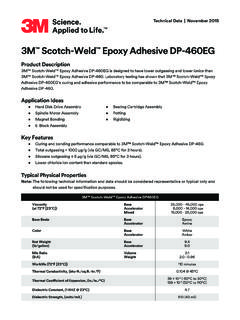Transcription of Keynotes No. 4 - Geotechnical Reports-Contract Doc
1 Keynotes RLGA. Technical Services No. 4 - Summer 2010. include all construction documents except the procure- Geotechnical Reports: contract ment requirements such as the instructions to bidders, Documents or Not? bid forms, and available information for bidders. That last item is what Geotechnical reports should be consid- By Ronald L. Geren, AIA, CSI, CCS, CCCA, SCIP ered: available information. The Geotechnical report is a document prepared by a Construction documents prepared by architects and Geotechnical engineer (who is typically hired by the engineers (A/Es) frequently include references to other owner) and consists of factual data, such as boring logs documents without any great concern. However, it may and findings from field and laboratory tests, as well as be of concern to A/Es and owners if some of those docu- interpretations of the data. These interpretations usually ments are incorporated into the contract documents. Of take the form of opinions and recommendations for use specific concern is the Geotechnical report , commonly by the design team in the preparation of the construction referred to as the soils report .
2 Documents. It is these opinions and recommendations Although it may be the owner's intention not to in- that prevent its use as a contract document. In the book clude the Geotechnical report as a contract document, the Subsurface Conditions: Risk Management for Design prime A/E or one of its consultants may include it by and Construction Management Professionals (By David reference in another area of the contract documents. J. Hatem, Esq., 1998, Wiley-IEEE), it states: Statements, such as A Geotechnical report is in- Some persons believe that all of the opinions and cluded and by its inclusion is hereby made a part of the recommendations in the GIR [ Geotechnical Interpre- contract documents (from an actual specification sec- tive/Investigative report ] should also be made part tion) and All paving, grading, excavation, trenching, of the contract documents, but it must be remem- pipe bedding, cut, fill, and backfill shall comply with the bered that the GIR was prepared by the Geotechnical recommendations in the soils ( Geotechnical ) report for engineer primarily for the use by the project de- this project (from an actual drawing) may be contrary to signer.
3 As such, not all of the Geotechnical engi- the owners intent. So, what is wrong with these state- neer's recommendations will necessarily be accepted ments? by the designer; the Geotechnical engineer may not The first one explicitly includes the Geotechnical re- be allowed to participate in the preparation of the port as a contract document. The second one indirectly contract documents; and/or the Geotechnical engi- makes the Geotechnical report a contract document by neer may not be allowed to visit the site during con- requiring compliance with its recommendations. The struction. To simply include the GIR as a contract problem is that the Geotechnical report should not be document, without any of the above follow-through included or even considered as a contract document. activities by the Geotechnical engineer, could be Before proceeding any further, it should be explained troublesome and could result in increased potential what the difference is between construction documents for claims.
4 And contract documents.. The content of the Geotechnical report is not contrac- Construction Documents vs. contract Documents tual in nature the text is not written in the mandatory language that is found in a contract document, such as The Construction Specifications Institute's (CSI) specifications or general conditions. Geotechnical re- Project Resource Manual defines construction docu- ports are replete with words such as should be, can ments as the written and graphic documents prepared or be, may be, should not be, and it is recom- assembled by the A/E for communicating the project mended, which, if allowed as a contract document, design for construction and administering the construc- would either conflict with the drawings and specifica- tion contract . contract documents, on the other hand, tions, or leave the decision completely up to the contrac- are only those documents that are specifically listed in tor; the latter, of which may be contrary to the designer's the agreement between the owner and contractor as be- intentions.
5 As an example, a report may recommend a ing a part of the contract . contract documents typically pavement cross section of a certain thickness. The de- 2010 RLGA Technical Services LLC Geotechnical Reports: contract Documents or Not? Keynotes No. 4 Page 1. Keynotes RLGA. Technical Services No. 4 - Summer 2010. signer will either accept the recommendation or make a the entire contents of the project manual in the owner- professional decision to go with a thicker section. In contractor agreement. The documents in Division 00 are either case, the contract documents should indicate the not specifications; therefore, it is important that only the thickness, and not refer back to the Geotechnical report . specifications Divisions 01 through 49 and each ap- plicable document in the contracting requirements be Geotechnical Reports in Procurement Documents enumerated as contract documents in the owner- contractor agreement. In all cases, consultation with Even though a Geotechnical report should not be in- your attorney and professional liability insurer is rec- cluded as part of the contract documents, it is strongly ommended.
6 Recommended that it be available to bidders so they can Even if bidders receive and read the Geotechnical re- draw their own conclusions based on the factual ele- port, under most instructions to bidders, bidders are re- ments of the report when preparing their bids or propos- quired to examine the site and local conditions (AIA. als. This doesn't mean that the design team should sup- Document A701-1997, Instructions to Bidders). Addi- press the nonfactual portions of the report that provide tionally, owners should allow bidders to access the pro- recommendations and options. Being selective in which ject site to make their own independent soil investiga- parts of the Geotechnical report are provided to bidders tions. may put the A/E and owner at risk by inadvertently de- leting significant information. Legal Implications When making the Geotechnical report available for bidders, there are two distinct practices that many A/E One compelling argument for keeping the geotech- firms use: nical report from becoming a contract document can be found in AIA Document A201-2007, General Condi- Bind the full report under 00 30 00 Available In- tions of the contract for Construction.
7 Section formation in the project manual. The advantage of allows the contractor to make a claim for unknown or binding the Geotechnical report in the project manual concealed conditions if they differ materially from is that it ensures that all plan holders have a copy those indicated in the contract Documents. If the geo- whether they read it or not is up to them. If this technical report was included as a contract document, method is used, a disclaimer preceding the report then any condition not indicated in the Geotechnical re- may be advisable. port may be considered as being materially different. Do not bind the Geotechnical report in the project One of the most well-known court cases involving a manual, but make it available upon request. Notice Geotechnical report and a set of contract documents is of its availability can be made in the advertisement Millgard Corp. v. McKee/Mays (49 1070 5th Cir. or invitation for bid, or the notice can be provided on 1995).
8 In that case, Millgard Corp., a foundation sub- a single page in Division 00, under the number and contractor, made a claim against McKee/Mays, the gen- title mentioned in the first bullet point, stating the eral contractor, and Dallas County (Texas), the owner, availability of the report , the location of where a for differing site conditions. Millgard Corp. cited a pro- copy can be obtained, and possibly a disclaimer. vision in the subcontract that allowed modifications for The advantage to not including the report in the pro- work performed if the actual conditions were at vari- ject manual is that it minimizes the perception that ance with the conditions indicated by the contract the Geotechnical report is a contract document; also Documents . it saves on printing costs if it is printed only on de- Fortunately for McKee/Mays and Dallas County, the mand. owner's instructions to bidders indicated that the [geo- technical] report is not a warranty of subsurface condi- A potential problem due to placing the Geotechnical tions, nor is it a part of the contract Documents.
9 The report in Division 00 or including a page indicating the court noted that if the soils report is not a part of the availability of one, is the unintentional inclusion of the contract documents, it cannot form the basis of a claim report into the contract documents by attaching or listing 2010 RLGA Technical Services LLC Geotechnical Reports: contract Documents or Not? Keynotes No. 4 Page 2. Keynotes RLGA. Technical Services No. 4 - Summer 2010. that conditions were at variance with the conditions in- conditions, the contract parties and the A/E need to be dicated by the contract Documents.' reasonable. Additionally, contractors need to follow the In Millgard v. McKee/Mays, the owner effectively provisions of the contract when encountering differing used a disclaimer stating that the owner does not warrant conditions, including prompt notice to the owner and the accuracy of the report 's content. However, the con- leaving the conditions undisturbed.
10 Tent of the disclaimer cannot gut the concealed condi- The Geotechnical report is an important tool used in tions clause of a construction contract (Foster Con- creating the design and preparing the construction struction v United States, 435 F2d 873; 193 Ct. Cl. 587, documents for a project. But if this tool, like any hand 1970). In other words, the disclaimer cannot shift all tool, is used improperly, you can place yourself and oth- risk to the contractor for unknown or concealed subsur- ers around you at risk. face conditions. Returning to Section of AIA Document A201, To comment on this article, suggest other topics, or the second condition in that section allows claims for submit a question regarding specifications or construc- unknown or concealed conditions if the discovered con- tion documents in general, contact the author at ditions are of an unusual nature, that differ materially from those ordinarily found to exist Therefore, if subsurface conditions differ from the report and are so About the Author: Ronald L.




